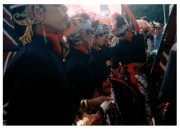 Also known as Jaran braid, Jaran Dor or elsewhere Kuda Lumping, Jathilan is a performance art that flourished in various parts of Yogyakarta. With that resemble woven bamboo horses, Jathilan shown generally in the afternoon and evening by a group of artists consisting of dancers and penggamel (gamelan players).
Also known as Jaran braid, Jaran Dor or elsewhere Kuda Lumping, Jathilan is a performance art that flourished in various parts of Yogyakarta. With that resemble woven bamboo horses, Jathilan shown generally in the afternoon and evening by a group of artists consisting of dancers and penggamel (gamelan players).
Previously, Jathilan is a ritual dance for the spirit of the horse and ask memeanggil village security and good harvests. According to its role in the Java community, the horse symbolizes power, obedience, and service attitude of the working class. It also inspired the whole performance that puts dancers Jathilan with a rocking horse as the center of attention.
At the beginning of its development, a group of dancers Jathilan consists of two roles: male dancers with horses and whips. Even so, art Jathilan played in a variety of official performances are now adopting some fundamental changes to the costumes, the dancers, as well as details of his movements.
The main storyline in Jathilan art reflects various problems that arise in the relationship between the upper classes and the workers. The working class is represented by the dancers portrayed a horse without rules, without ceasing to move; pacak golu (Moving head from side to side), siring (shifted laterally by half a run), njondil (jump), roll over, even possessed.

Around him, a man with whips, always keep an eye on the actions of the horse. They are described as leaders who are fewer in number, not sloppy, and has the authority. The impression of arrogance and flat with no strings attached is raised by the dominance of bright red and black on makeup and clothes. These figures move around the dancers rotate horses in the arena of "fun" to the music. Every now and then lashed her horse whip to warn dancers if they act "too far".
 Reflecting that this art originated and evolved in the lower classes, at least the impression is also radiated from the accompanying music. If observed, the resulting sounds seem flat and monotonous. But it's not without purpose. In addition to presenting the impression of a magical, it symbolizes the everyday lower-class workers who filled routine.
Reflecting that this art originated and evolved in the lower classes, at least the impression is also radiated from the accompanying music. If observed, the resulting sounds seem flat and monotonous. But it's not without purpose. In addition to presenting the impression of a magical, it symbolizes the everyday lower-class workers who filled routine.
Penggamel group consists of only a few people who played a simple gamelan set consisting of one each saron, drums, gongs, and kempul. In general, Jathilan in Yogyakarta has not fundamentally changed in terms of musical accompaniment.Impression of a static tempo rhythm with slight variations "surge" here and there retained.
When the rhythm accompaniment crept up, dancing horse look more wild and uncontrolled. At the climax of the show, they often look possessed. This phase has been waiting for the audience. This is when the dancers perform the horse-style attractions Debus Banten. They like to eat out of consciousness as glass, peeling coconuts with their teeth, break the shell with the forehead, and then drink the water. Not infrequently, they also eat flowers and offerings of drinking contaminated water from a bucket like a horse.
At the end of the show, the strains of gamelan music back to its original tempo as the man bercemeti play its function as a healer. She hugged the man possessed, spells, and menyemburnya with water. Instantly tightens the trance dancers, and then returned to consciousness as madness does not know what he was doing before
source : http://dijogja.wordpress.com







Tidak ada komentar:
Posting Komentar